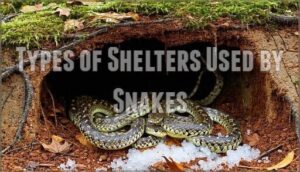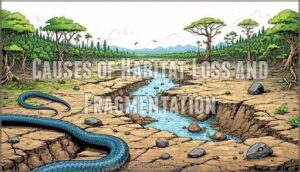This site is supported by our readers. We may earn a commission, at no cost to you, if you purchase through links.
 You’ll find snake habitat in Australasia varies dramatically between Australia and New Zealand.
You’ll find snake habitat in Australasia varies dramatically between Australia and New Zealand.
Australia hosts snakes in virtually every environment—from scorching deserts and tropical rainforests to suburban gardens and coral reefs where sea snakes patrol. These adaptable reptiles thrive in wetlands, rocky outcrops, grasslands, and even your backyard shed.
New Zealand tells a different story entirely—it’s completely snake-free due to geographic isolation that prevented any species from naturally colonizing the islands.
This means Aussies need constant awareness of their slithery neighbors, while Kiwis can hike worry-free. Understanding specific regional populations, seasonal behaviors, and preferred hiding spots becomes essential knowledge.
Table Of Contents
- Key Takeaways
- Types of Snake Habitats
- Regions Prone to Snake Infestations
- Urban Vs Rural Snake Habitats
- Snake Shelter and Hiding Spots
- Factors Affecting Snake Habitat
- Snake Migration and Dispersal
- Snake Habitat Loss and Fragmentation
- Snake Habitat and Human Interaction
- Conservation of Snake Habitats
- Frequently Asked Questions (FAQs)
- Do snakes live in Australia?
- What snakes live in Australian deserts?
- Why do snakes live in deserts in Australia?
- How do Australian snakes survive?
- Where do tiger snakes live in Australia?
- Where do brown snakes live in Australia?
- Where are snakes found in Australia?
- Do snakes live underground in Australia?
- Are snakes common in Australian homes?
- How did Australia get so many snakes?
- Conclusion
Key Takeaways
- You’ll find dramatic habitat differences – Australia hosts 140+ snake species in every environment from deserts to coral reefs, while New Zealand remains completely snake-free due to geographic isolation
- You need location-specific awareness – Eastern Australia’s high-density populations require constant vigilance, while northern regions offer tropical snake paradises with year-round activity in warm, wet climates
- You can expect snakes in both urban and rural settings – They’re adapting to city life with steady food sources and warm surfaces, plus thriving in traditional rural habitats with natural shelter and prey
- You’re witnessing serious habitat threats – Urbanization, agriculture, and climate change are fragmenting snake territories by up to 50%, making conservation efforts crucial for maintaining Australia’s remarkable snake diversity
Types of Snake Habitats
Australia’s diverse landscapes create distinct snake habitats ranging from scorching deserts to lush rainforests.
Australia’s varied terrain supports snakes from blistering outback sands to tropical coastal waters.
You’ll find these reptiles thriving in three main environments: on land, in freshwater systems, and even in marine waters around the coast, particularly in freshwater systems.
Terrestrial Habitats in Australia
Across Australia’s vast terrain, you’ll find snakes thriving in surprisingly diverse terrestrial environments that showcase nature’s adaptability.
These resilient reptiles have mastered survival in:
- Desert Ecosystems – where sand-dwelling species bask on sun-warmed rocks
- Forest Floors – providing cool shelter beneath fallen logs and leaf litter
- Rocky Outcrops – offering perfect crevices for hiding and temperature regulation
- Grassland Habitats – supporting active hunters in open plains
- Arid Landscapes – where specialized species conserve water efficiently
From bustling suburbs to remote wilderness, Australasian snake habitats demonstrate remarkable ecological diversity across the continent.
Freshwater Habitats in Australia
Australia’s freshwater ecosystems support remarkable snake diversity across wetlands, rivers, and swamps.
You’ll encounter species like MacLeay’s water snake thriving in aquatic life-rich environments.
Water quality and seasonal flooding directly influence Australasian snake habitats.
These river ecosystems require careful wetland conservation to maintain healthy freshwater ecology supporting Australian wildlife.
Always respect these essential snake habitats when exploring waterways.
Marine Habitats in Australia
Diving into Australia’s Great Barrier Reef reveals stunning sea snakes perfectly adapted to marine ecosystems.
These Australasian snakes thrive in ocean habitats, coastal regions, and mangroves with flattened tails for swimming.
Coastal biodiversity flourishes here, though reef conservation efforts protect these remarkable creatures from fishing pressure and habitat loss.
Adaptations to Different Environments
Sea snakes dominate tropical waters, but land species showcase remarkable ecological adaptations that’ll blow your mind.
Thermal regulation helps poikilothermic snakes survive Australia’s extreme temperatures, while habitat flexibility lets them thrive from alpine regions to coastal regions.
Camouflage tactics and venom variation prove nature’s genius:
- Death Adders vanish into leaf litter like ghosts
- Desert adaptations help species survive scorching heat
- Body shape varies dramatically between environments
- Amethystine Pythons squeeze prey with crushing power
Regions Prone to Snake Infestations
Australia’s diverse regions create distinct patterns of snake populations, with some areas experiencing higher concentrations than others.
You’ll find that climate, geography, and habitat availability determine which regions become hotspots for snake activity throughout the continent, characterized by distinct patterns.
Eastern Australia’s Snake Population
Eastern Australia’s Snake Distribution spans over 30 species, creating remarkable Habitat Diversity across woodlands and farmlands.
The Eastern brown snake dominates these snake populations, while Climate Impact drives year-round activity in warmer zones.
Australian snake diversity thrives through:
- Open grasslands supporting high-density populations
- Watercourses providing shelter in arid zones
- Urban edges concentrating snake habitats
- Farmland offering abundant rodent prey
- Species Conservation protecting ecosystem balance
Human encounters peak during active seasons, making Venom Types awareness essential for coexistence.
The eastern brown snake’s presence is often associated with rural agricultural areas, where they prey on introduced rodents.
Western Australia’s Snake Population
Moving west from the eastern territories, you’ll find Western Australia’s desert snakes thriving in harsh conditions.
These arid adaptations showcase remarkable evolutionary engineering.
Coastal species along the shoreline demonstrate Australian snake diversity at its finest.
| Species | Habitat | Key Feature |
|---|---|---|
| Tiger Snake | Wetlands/suburbs | Highly venomous |
| Dugite | Woodlands/scrub | Fast striker |
| Woma Python | Desert burrows | Constrictor |
Western pythons and other snake populations use snake migration patterns to navigate between desert habitats.
You’ll spot them basking on sun-warmed rocks or hiding beneath fallen logs in Western Australia’s diverse snake habitats.
Northern Australia’s Snake Population
While Western Australia showcases desert-adapted species, Northern Australia’s tropical climate creates a snake paradise.
You’ll find diverse venomous species and tropical snakes thriving in these northern ecosystems.
The region’s warm temperatures and abundant rainfall support remarkable Australian snake species diversity throughout Australasia’s snake habitats.
- MacLeay’s water snakes spread across flooded wetlands during monsoon seasons
- Death adders camouflage perfectly among fallen leaves in tropical forests
- Olive pythons hunt near billabongs where prey comes to drink
Southern Australia’s Snake Population
Southern Australia’s temperate climate supports fewer snake species than northern regions, but you’ll still encounter venomous types like Tiger snakes.
These territorial reptiles adapt well to diverse Australian snake habitats, from deserts to suburbs.
Habitat Loss threatens Species Diversity, making Conservation Status monitoring essential for maintaining healthy snake population numbers across Southern Australia.
Urban Vs Rural Snake Habitats
You’ll find snakes thriving in both bustling cities and quiet countryside, but their habitat preferences reveal fascinating patterns about survival and adaptation.
Urban environments offer unexpected advantages like steady food sources and warm microclimates, while rural areas provide traditional shelters and fewer human disturbances, which is crucial for their adaptation.
Snakes in Urban Areas
You’ll find snakes thriving in cities thanks to abundant food and shelter opportunities.
Urban snake encounters happen because gardens, sheds, and buildings create perfect hiding spots.
| Urban Attraction | Snake Response |
|---|---|
| Food sources (rodents, frogs) | Increased hunting activity |
| Warm surfaces (concrete, roofs) | Extended basking periods |
| Water features (pools, fountains) | Regular drinking visits |
Snake repellents and urban planning help manage these interactions, but understanding snake behavior in urban zones remains key for human safety and effective urban snake conservation.
Effective snake control often involves using a snake repellent system to deter them from inhabited areas.
Snakes in Rural Areas
Beyond city limits, rural bushland offers snakes abundant natural shelter and prey.
You’ll encounter diverse species in farm habitats where logs, rock piles, and dense vegetation create perfect hideouts. Australian snake ecology thrives in these undisturbed areas.
| Habitat Feature | Snake Benefit | Your Action |
|---|---|---|
| Fallen logs | Perfect hiding spots | Check before moving |
| Tall grass | Hunting grounds | Keep areas trimmed |
| Rock piles | Thermal regulation | Inspect carefully |
Rural conservation efforts protect habitat diversity, supporting healthy snake prey dynamics while ensuring safer rural snake encounters for everyone.
Factors Affecting Habitat Choice
When snakes scout for the perfect home, they’re like real estate agents with very specific checklists. Food Availability tops their priorities – urban areas offer steady rodent populations around garbage and bird feeders, while rural locations may require longer hunting trips. Temperature Regulation becomes critical since snakes can’t generate their own heat like mammals.
Shelter Options vary dramatically between settings. Cities provide concrete structures, garden sheds, and warm foundations, whereas rural Australian ecosystems offer hollow logs, rock crevices, and dense vegetation. Predator Avoidance influences habitat preferences too – urban snakes face fewer natural threats but more human encounters.
Here’s how these factors compare:
| Factor | Urban Impact | Rural Impact |
|---|---|---|
| Food Sources | Concentrated prey around homes | Scattered, seasonal availability |
| Temperature Control | Heat islands from pavement | Natural thermal gradients |
| Shelter Availability | Artificial structures abundant | Natural hiding spots limited |
| Competition Levels | Higher snake density | Lower population pressure |
These ecological niches shape geographic distribution patterns across snake habitats, determining where species thrive.
Human Impact on Snake Habitats
Through urbanization and habitat destruction, you’re witnessing Australia’s snake populations face mounting pressure.
Human encroachment fragments their territories, while pollution effects and climate change compound survival challenges.
The loss of genetic diversity is a significant concern, particularly in cases of snake inbreeding.
| Impact Type | Primary Effects | Conservation Response |
|---|---|---|
| Habitat Loss | 70% wetland destruction in Perth | Protected area expansion |
| Urbanization | Reduced genetic diversity | Corridor restoration projects |
| Agriculture | Barrier creation for dispersal | Conservation efforts funding |
| Infrastructure | Population isolation | Community education programs |
| Fragmentation | Inbreeding in tiger snakes | Habitat connectivity planning |
Human impact on snake habitats disrupts ecosystem balance through land clearing and development pressures.
Snake Shelter and Hiding Spots
You’ll find snakes seeking shelter in surprisingly diverse spots throughout Australasia, from natural rock crevices to your garden shed.
Understanding where these reptiles hide helps you spot potential snake zones and appreciate their survival strategies.
Types of Shelters Used by Snakes
Throughout Australasia, you’ll discover snakes making homes in diverse Rocky Outcrops and Tree Hollows.
These clever reptiles utilize Burrow Systems, Log Piles, and Coastal Caves as primary snake shelters.
From narrow rock crevices to spacious tree hollows in bushlands, each shelter type offers protection from predators while helping snakes regulate body temperature in their chosen snake dens.
The selection of suitable snake shelter options is essential for their survival.
Hiding Spots in Natural Environments
Natural environments offer countless hiding spots where you’ll find snakes taking shelter.
Rock crevices in Rocky Outcrops provide cool retreats, while fallen logs on Forest Floors create perfect ambush points.
Grassland Hideouts include dense vegetation and rodent burrows.
Wetland Refuges offer muddy banks and reed beds.
In arid regions, Desert Burrows and sandy depressions become essential snake shelter locations for temperature regulation and protection.
Hiding Spots in Human-Made Environments
Your property’s Urban Shelters create perfect snake habitats in unexpected places.
These humanmade environments attract snakes seeking warmth and protection from predators.
- Backyard Hides under woodpiles, sheds, and stored equipment provide ideal hiding spots
- Garden Dens beneath dense vegetation, compost heaps, and decorative Rock Piles offer shelter
- Fence Lines with gaps, overgrown areas, and debris create secure corridors for movement
Reasons for Snake Hiding Behavior
Beyond human-made shelters, you’ll find snakes hide for three key survival reasons.
Their snake hiding spots serve critical functions that guarantee their survival in Australia’s diverse environments.
- Predator Avoidance: Snakes use camouflage tactics and shelter seeking to avoid becoming someone else’s lunch
- Thermal Regulation: They’re nature’s ultimate thermostat adjusters, moving between sun and shade
- Food Security: Strategic positioning near prey corridors maximizes hunting success while minimizing energy expenditure
Factors Affecting Snake Habitat
You’ll find that snake habitats across Australasia aren’t just determined by what looks like suitable terrain.
Climate patterns, geological features, human development, and natural disasters all play pivotal roles in shaping where these reptiles can actually survive and thrive, influenced by complete concepts such as these factors.
Climate and Weather Patterns
Australia’s climate zones create distinct challenges for snakes.
Temperature fluctuations from -7.5°C to 50.6°C force species to adapt their activity patterns.
During heat waves, snakes become nocturnal to avoid deadly overheating.
Rainfall patterns determine breeding cycles – tropical species time reproduction after wet seasons when soil moisture supports egg development.
Weather extremes like La Niña increase snake encounters as flooding displaces them toward human areas.
Geographical Features and Landforms
Australia’s diverse geography shapes where you’ll find snakes thriving.
Mountain Ranges like the Great Dividing Range create cool alpine regions with fewer species.
While Desert Landforms in the outback host heat-loving serpents, River Systems and wetlands support water snakes.
Coastal Erosion creates rocky hideouts, and tropical forests plus grasslands offer abundant prey and shelter opportunities.
Human Activities and Development
Human activities reshape snake habitats through Urban Planning and Development Effects.
You’ll find urbanization creates barriers that fragment natural areas, while Land Use changes eliminate shelter sites.
Human Impact on snake populations includes:
- Habitat Destruction from road construction
- Pollution affecting water sources
- Building development removing vegetation
- Agricultural expansion displacing native species
Conservation efforts help balance development with wildlife needs.
Natural Disasters and Their Impact
When natural disasters strike, they reshape snake habitats dramatically.
Flood Effects displace snakes from burrows, forcing temporary relocations.
Wildfire Consequences destroy shelter and prey sources, creating barren landscapes.
Drought Influence concentrates snakes near remaining water sources.
Storm Impacts and Earthquake Damage fragment territories.
These natural disasters accelerate habitat destruction, disrupting ecological balance and pushing resilient species into new territories.
Snake Migration and Dispersal
You’ll find that snakes in Australasia don’t just stay put in one spot their whole lives—they’re surprisingly mobile creatures that move around for food, mates, and better living conditions.
Understanding their migration patterns helps you predict where you might encounter these reptiles during different seasons and why certain areas see population booms at specific times of year, which can be influenced by their search for better living conditions.
Reasons for Snake Migration
When snakes hit the road, they’re chasing basic survival needs that keep them alive and thriving.
Food Availability drives most movements—you’ll find snakes following prey populations like mice or frogs to new areas.
Climate Change and Temperature Fluctuations push species toward cooler or warmer zones as seasons shift.
Water Sources become magnets during dry spells, while Habitat Destruction from development forces emergency relocations.
- Seasonal food shortages trigger long-distance searches for abundant prey populations
- Breeding season demands compel snakes to seek ideal nesting sites with proper temperatures
- Water scarcity during droughts forces movement toward reliable freshwater sources
- Predator pressure motivates relocation to safer territories with better hiding spots
- Climate influence on snake habitats creates temperature-driven migrations between summer and winter ranges
Methods of Snake Dispersal
Sometimes passive dispersal happens by pure chance, like winning nature’s lottery.
You’ll find snakes traveling through various methods, often beyond their control.
| Method | Description |
|---|---|
| Wind drift | Small species carried by strong winds |
| Water rafting | Floating on logs or debris downstream |
| Hitchhiking | Accidentally transported by vehicles or cargo |
| Animal transport | Carried by larger animals or birds |
| Debris riding | Using natural materials as transportation |
These dispersal patterns help species movement into new territories, expanding snake distribution across fragmented landscapes and creating unexpected habitat expansion opportunities.
Factors Affecting Migration Patterns
Climate Change reshapes Australian snake migration as temperatures rise up to 5°C, extending active seasons and altering movement windows.
Food Availability drives nocturnal species to track prey cycles, while Water Sources determine wetland-dependent snake routes.
Terrain Barriers like roads fragment populations, and Human Activity forces detours through developed landscapes, disrupting traditional snake migration patterns.
Impact of Migration on Snake Populations
You’ll notice that snake migration patterns directly influence population health and survival across Australian snake species.
When snakes can freely move between habitats, they maintain stronger genetic diversity and access essential resources.
However, habitat loss and fragmentation disrupt these natural population dynamics, creating isolated groups that struggle to survive.
Consider how species movement affects snake populations:
- Genetic lifelines – Migration prevents dangerous inbreeding in small populations
- Resource highways – Snakes find new food sources and breeding grounds through habitat shift
- Climate escape routes – Movement helps populations survive environmental changes
- Population boosters – Snake dispersal replenishes declining local groups
- Survival networks – Connected habitats support larger, more stable snake populations
When barriers block these natural pathways, Australian snake species face serious consequences.
Isolated populations become vulnerable to disease, genetic problems, and local extinction.
That’s why protecting migration corridors matters as much as preserving individual snake habitats.
Snake Habitat Loss and Fragmentation
You’re witnessing Australia’s snake habitats disappear at an alarming rate, with urbanization and agriculture fragmenting once-continuous landscapes into isolated patches.
This habitat destruction doesn’t just shrink available space—it creates deadly barriers that prevent snakes from finding mates, food sources, and suitable shelter across their traditional territories, leading to a significant impact on their ability to survive and thrive in their traditional territories.
Causes of Habitat Loss and Fragmentation
Understanding snake migration patterns reveals how human activities disrupt their natural movements.
Deforestation and urbanization fragment once-continuous habitats into isolated patches.
Agricultural expansion, mining operations, and infrastructure development create barriers that snakes can’t cross.
| Threat Type | Primary Impact | Example in Australasia |
|---|---|---|
| Deforestation | Removes shelter/prey | Clearing for cattle ranching |
| Climate Change | Alters temperature zones | Drought in Western Australia |
| Urbanization | Creates physical barriers | Suburban sprawl in Queensland |
| Pollution | Contaminates water sources | Agricultural runoff in wetlands |
Habitat fragmentation isolates populations, while pollution degrades remaining areas.
Climate change shifts suitable temperature ranges faster than snakes can adapt.
Effects of Habitat Loss on Snake Populations
Habitat Destruction hits snake populations hard across Australasia.
Australia’s shrinking wilderness leaves snakes with nowhere to hide as concrete replaces their ancient homes.
You’ll see Population Decline when forests shrink by nearly 50%, forcing species into isolated patches.
Biodiversity Loss accelerates as genetic diversity drops 30-40% in urban areas.
Snake Extinction threatens small-range species, while Ecosystem Disruption ripples through food webs when these predators vanish completely.
Conservation Efforts to Protect Snake Habitats
Today’s conservation efforts combine habitat preservation with snake research to protect Australia’s reptile populations.
Protected areas and national parks safeguard critical ecosystems, while habitat restoration projects rebuild degraded environments.
Scientists develop conservation strategies through field studies and population monitoring.
Wildlife protection programs educate communities about coexistence, reducing persecution.
Ecosystem management practices guarantee sustainable land use that benefits both snakes and other native species.
Strategies for Mitigating Habitat Loss
Success hinges on Wildlife Corridors connecting fragmented snake habitats across Australia.
You’ll need Habitat Preservation through protected zones, plus Ecosystem Restoration of degraded areas. Conservation Planning teams with landowners create buffer zones around critical habitats.
Sustainable Development practices guarantee new projects don’t block migration routes. These habitat restoration efforts give Australian snake conservation real teeth.
Effective snake care also involves understanding proper snake habitat design to replicate their natural environments.
Snake Habitat and Human Interaction
You’ll encounter snakes throughout Australasia as urban development and agriculture bring humans into closer contact with these adaptable reptiles.
Understanding how snakes interact with human environments helps you coexist safely while appreciating their essential role in controlling pest populations, which is crucial for maintaining a balance in the ecosystem, and this understanding can lead to a better coexist.
Conflicts Between Humans and Snakes
While habitat loss forces more human encounters, most conflicts stem from human fear rather than actual snake attacks. You’re more likely to step on a garden rake than face a venomous bite.
When snake human interaction occurs, it’s usually because you’ve wandered into their territory or blocked their escape route. Urban adaptation has increased encounters, making snake removal and conflict resolution skills valuable.
Most incidents happen when people try handling snakes themselves instead of calling professionals.
- Coexistence strategies start with respecting snake space and behavior patterns
- Most bites occur during attempted capture or when snakes feel cornered
- Human impact on snake habitats drives them into suburban areas seeking food
- Night encounters increase during warm months when snakes hunt actively
- Professional removal services prevent dangerous DIY snake handling attempts
Strategies for Coexisting With Snakes
Living harmoniously with snakes means Snake Safety through smart Coexistence Tips. Seal gaps, remove food sources, and keep yards tidy. When you spot a snake, stay calm and give it space—most encounters end peacefully when you don’t panic.
| Prevention Strategy | Action Steps |
|---|---|
| Home Security | Seal cracks, remove brush piles, install mesh barriers |
| Garden Management | Clear debris, trim vegetation, eliminate water sources |
| Encounter Protocol | Stop movement, back away slowly, call professionals |
| Community Planning | Support Wildlife Conservation, promote Human Education |
Understanding snake behavior helps reduce conflicts. Most species avoid humans naturally. Urban Planning that considers snake habitats creates safer neighborhoods.
Supporting habitat restoration and snake conservation helps these creatures maintain their ecological role while respecting human spaces. Effective management of snake habitat is vital for minimizing human-snake conflicts in suburban areas, and this approach will help maintain a balance that’s necessary for minimizing such conflicts.
Education and Awareness Programs
Public education programs bridge knowledge gaps after implementing safety strategies.
Community outreach initiatives teach residents about snake behavior and habitat preservation through hands-on workshops.
Effective education programs focus on:
- Teaching proper first aid techniques that could save your life during emergencies
- Breaking harmful myths that lead to unnecessary snake killings
- Showing identification methods to distinguish venomous from harmless species
- Promoting habitat conservation efforts that benefit entire ecosystems
- Building community networks for reporting and managing snake encounters safely
Research on Snake Behavior and Habitat
Scientific studies reveal fascinating Snake Behavior patterns across Australasian habitats. Researchers use radio telemetry and camera traps to track movement patterns, discovering how Environmental Adaptation shapes survival strategies.
Australian snake research uncovers territorial behaviors and feeding cycles that’ll surprise you.
| Research Focus | Key Discovery |
|---|---|
| Movement Patterns | Snakes travel up to 2km during breeding season |
| Feeding Behavior | Most species hunt within 100m of shelter |
| Habitat Preferences | 80% favor areas with consistent water access |
Species Interaction studies show complex relationships between predators and prey, while Habitat Ecology research maps critical breeding grounds. These Research Methods help us understand snake habitats better, supporting conservation efforts that protect both wildlife and communities.
Conservation of Snake Habitats
You’ll discover that protecting snake habitats requires coordinated efforts across multiple levels, from government-managed reserves to grassroots community programs.
These conservation strategies both safeguard Australia’s remarkable snake diversity and maintain the ecological balance that keeps entire ecosystems functioning smoothly, which is crucial for ecological balance.
Protected Areas and National Parks
Across Australia’s protected areas, national parks serve as essential sanctuaries where snakes flourish without human interference.
These reserves maintain ecological balance through careful Park Management and Wildlife Conservation strategies that protect Australian snake habitats while ensuring visitor safety.
Understanding the importance of snake habitat preservation is imperative for conservation efforts.
Here are five key benefits of National Reserves for snake conservation:
- Habitat Preservation – Protected areas prevent development that destroys critical snake environments
- Research Opportunities – Scientists study snake behavior and population trends in undisturbed settings
- Ecosystem Integrity – Snakes control rodent populations, maintaining natural food webs
- Species Recovery – Threatened snake species rebuild populations in safe environments
- Education Centers – Parks teach visitors about snake importance through guided programs
Habitat Restoration and Rehabilitation
Think of habitat restoration as ecosystem repair for snake habitats.
Wetland renewal, reforestation, and tackling invasive species are key Rehabilitation Methods.
Even herding cats—aka community engagement—matters for Wildlife Conservation.
Effective wetland restoration techniques are essential for conservation.
Here’s a quick look:
| Action | Benefit |
|---|---|
| Wetland Renewal | Boosts Environmental Recovery |
| Reforestation | Supports Habitat Renewal |
| Remove Invasives | Restores Ecosystem Balance |
| Community Involvement | Sustains Conservation Efforts |
Research and Monitoring Programs
Modern research and monitoring programs track Australian snake diversity like never before.
You’ll find scientists using cutting-edge technology to understand population trends and conservation strategies across diverse snake habitats.
- Drone radio-telemetry – World-first tracking projects monitor Eastern Brown Snakes across challenging terrain
- Environmental DNA analysis – Non-invasive detection maps cryptic sea snake populations in marine parks
- Industry collaboration – Commercial fisheries report bycatch data, improving species tracking accuracy fourfold
- Camera traps and acoustic devices – Cost-effective habitat mapping tools complement traditional survey methods
Community Involvement in Conservation Efforts
Many volunteer programs and conservation education initiatives rely on your participation to protect Australian snake habitats.
Community engagement through public awareness campaigns and cooperative research projects strengthens community outreach and conservation efforts.
You can join snake conservation programs, participate in Australian wildlife conservation projects, and support habitat restoration activities that make a real difference for these essential predators.
Frequently Asked Questions (FAQs)
Do snakes live in Australia?
Yes, you’ll find snakes thriving throughout Australia.
With over 140 land species and 30+ sea snakes, they’ve adapted to every habitat from scorching deserts to tropical rainforests.
Making Australia a true snake paradise.
What snakes live in Australian deserts?
Australian deserts host several snake species including the King Brown, Dugite, Banded Sand Snake, and Pygmy Python.
You’ll find Tiger Snakes and Death Adders too, all perfectly adapted to scorching temperatures and scarce water through specialized camouflage and heat tolerance.
Why do snakes live in deserts in Australia?
Desert dwellers don’t just survive—they thrive in Australia’s sun-baked wastelands.
You’ll find snakes there because deserts offer abundant shelter, steady warmth for temperature regulation, and prey like rodents that’ve adapted to arid conditions.
How do Australian snakes survive?
You’ll find snakes use behavioral thermoregulation—basking on rocks, burrowing underground, or seeking shade—to manage their body temperature since they’re cold-blooded and can’t generate internal heat.
Where do tiger snakes live in Australia?
Like scattered puzzle pieces across a vast continent, you’ll discover tiger snakes throughout southern Australia’s diverse landscapes.
They’re territorial homebodies in South Australia, Victoria, Tasmania, and southern Western Australia, thriving in wetlands, coastal areas, and even suburban gardens where they’ve adapted remarkably well.
Where do brown snakes live in Australia?
You’ll find brown snakes throughout eastern Australia, especially in Queensland and New South Wales.
They’re highly venomous, preferring open woodlands, scrublands, and even suburban areas where they hunt during daylight hours.
Where are snakes found in Australia?
With 140+ land snake species spread across 6 million square kilometers, you’ll encounter snakes everywhere from tropical Queensland rainforests to Western Australia’s scorching deserts, urban backyards to alpine regions.
Do snakes live underground in Australia?
Yes, you’ll find several Australian snake species living underground.
Woma pythons burrow in sandy soils, while blind snakes spend most of their lives in underground tunnels hunting termites and ant larvae.
Are snakes common in Australian homes?
Imagine this scenario: you’re settling in for the night when something slithers across your floor.
Snakes do enter Australian homes occasionally, seeking food, water, or warmth, but they’re not regular houseguests throughout most regions, particularly in areas where they are less common.
How did Australia get so many snakes?
Australia’s isolation as an island continent for 45 million years allowed snakes to evolve and diversify without major disruptions, creating over 140 unique species perfectly adapted to its varied climates.
Conclusion
Understanding snake habitat in Australasia couldn’t be more mind-blowingly different between these neighboring regions.
Australia’s snakes have conquered virtually every ecosystem imaginable, from your garden shed to coral reefs. They’ve adapted to scorching deserts, lush rainforests, and bustling cities with remarkable success.
Meanwhile, New Zealand remains completely snake-free due to its geographic isolation.
You’ll need solid knowledge of local snake populations, seasonal patterns, and preferred hiding spots to safely coexist with Australia’s diverse serpent communities while enjoying New Zealand’s worry-free wilderness adventures, which is a remarkable difference, and allows for diverse experiences.
- https://www.aims.gov.au/research-topics/marine-life/sea-snakes
- https://www.nespmarine.edu.au/project/project-a8-exploring-status-western-australian-sea-snakes.html
- https://kids.kiddle.co/Australian_snake_habitats
- https://www.australia-backpackersguide.com/snakes-in-australia/
- https://www.wildlife.vic.gov.au/__data/assets/pdf_file/0018/84114/Tiger-Snake.pdf




















